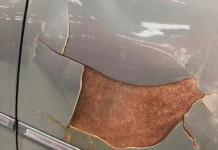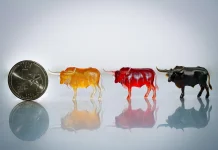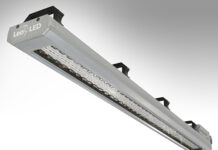By Jo Ann Arceneaux, Ph.D. and Celia Buono, allnex USA Inc.; and Kevin Poelmans, Ph.D., allnex Belgium
UV LED cure in 2018
Since its introduction in 2002, UV LED technology has steadily gained traction in converting and industrial areas. Early adoption applications include inkjet and screen printing, structural bonding adhesives and electronic assemblies. For printing applications, a mercury lamp was generally used at the end of the press to fully cure the ink and overprint varnishes (OPVs). Today, UV LED cure is being used for the entire converting operation. Flexo presses are being sold or retrofitted to fully use UV LED lamps. These presses include four-color process inks, plus white inks and clear coats or OPVs. For industrial coating lines (i.e. wood coating), the use of UV LED lamps also is growing. However, no full UV LED commercial coating lines are operational today.
The advantages of UV LED lamps have been discussed in several studies, and they are reported to be 50 percent more energy efficient than UV mercury lamps.1 There also are increasing regulations around the use of mercury lamps. Legislation to ban/limit the use of mercury lamps may be forthcoming sometime around the year 2020.
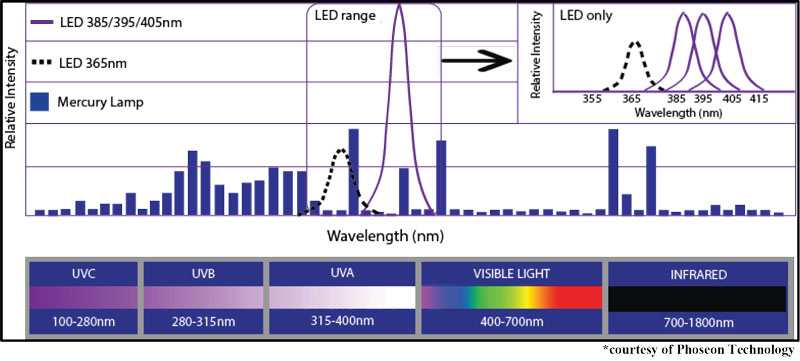
In the past, UV curing systems have typically consisted of one or two medium-pressure mercury bulbs with broad spectral emissions and with the wattage steadily increasing over the years from 200 to 600 watts per inch. (Figure 1.) These systems were generally designed to obtain the fastest cure speed possible, with productivity gains the ultimate goal. Today, curing systems, such as UV LED lamps, are being designed with additional goals in mind. Safety and environmental concerns, cure temperature, energy consumption and maintenance schedules all influence the design of these new curing systems. Productivity is expected to remain the same as systems equipped with mercury lamps, but some of the newer cure systems deliver less energy to the coating and, more importantly, eliminate shorter wavelength UV. Both of these factors tend to increase the impact of oxygen inhibition on UV cure and can negatively impact productivity.
Increasing the irradiance increases the concentration of free radicals, and higher concentrations of free radicals consume more oxygen. Conversely, low-energy cure systems, with lower irradiance, result in lower concentrations of free radicals and more oxygen inhibition. The irradiance should be measured at the substrate to determine the delivered power because delivered power decreases with distance from the lamp to the substrate. With some UV LED lamps, increased irradiance does not always lead to increased cure speed because the delivered energy density (Joules/cm2) can vary with the type of UV LED lamp.2
There also is a wavelength dependence on absorption of UV. UV-curable materials exhibit a higher absorbance to short wavelength energy (UVC) than to longer wavelength energy. As a result, short wavelength energy does not penetrate much beyond the surface, and longer wavelength energy (UVB and UVA) survives to penetrate deeper into the material. (See Figure 1 for wavelength nomenclature.) UV LED lamps do not emit UVC wavelengths, resulting in increased oxygen inhibition at the surface of the coating. However, through-cure generally is very good.
Most UV LED lamps used on printing presses today emit wavelengths centered around 395 nm, in the UVA range. UV LED lamps with 385 nm and 405 nm emission bands also are used, and lamps with 365 nm emission bands are available, but only at lower intensity. (Figure 1.) Since their introduction, UV LED lamps have seen a steady increase in peak irradiance, from 1.1 watts/cm2 to 24 watts/cm2. Improvements in the optics of UV LEDs have led to an increase in the irradiance delivered to the substrate surface.
Overcoming oxygen inhibition
Generally, decreasing the viscosity of a coating increases the oxygen diffusion into the coating and, consequently, decreases surface cure due to oxygen inhibition.3 However, at equal viscosity, formulations with the following characteristics will have better surface cure (less oxygen inhibition): 1) increased acrylate functionality or double-bond concentration and 2) ether, amine, thiol and/or other special structural component in the backbone.4
Oxygen inhibition of surface cure is due to both quenching and scavenging reactions during free radical polymerization. The end result is less polymer formation and/or lower molecular weight polymer chains. In either case, the reaction with oxygen may give a range of results, from reduced coating properties to uncured, liquid surfaces on the coating.4
There are known physical and chemical ways to reduce oxygen inhibition and improve surface cure, and these have previously been discussed.4 Also, thicker coatings suffer less from oxygen inhibition due to the bulk polymerization reaction, which increases viscosity and significantly reduces oxygen diffusion.5 Decreasing the distance from the lamp to the substrate increases the irradiance delivered to the substrate and improves surface cure. Increasing the exposure time, via slower cure speeds or multiple lamps, also generally increases the extent of cure.4
The use of reactive chemicals is the most commonly implemented solution to mitigate oxygen inhibition. The chemicals that react with peroxy radicals contain easily abstractable hydrogen atoms. These abstractable hydrogen atoms are found in compounds containing specific structural elements, sulfur (thiols), nitrogen (amines) or oxygen (ethers). The hydrogens on the carbon atoms alpha to the sulfur, nitrogen or oxygen are those that are easily abstractable, and there are many of these in each molecule. The efficacy of these compounds, for the same equivalency, is thiols > amines > ethers. Improvements in performance are noted when the thiols, amines and polyethers are acrylated. The acrylate functionalities ensure that the materials become part of the polymer backbone after cure and cannot migrate or bloom to the surface. A reduction in odor also may be obtained through acrylation.
The most commonly used solution within the reactive chemicals category is the use of amino acrylates. Overprint varnishes, inks and industrial coatings all use this technology. In some cases, added benefits – such as improved adhesion and increased color strength – are obtained. Increased yellowing on cure is seen with some amino acrylates, and this can be a problem for OPVs, clear coatings and white inks or coatings.

For amino acrylates to fully function, a Type II photoinitiator should be utilized. Figure 2 shows the photoabstraction reactions of a Type II photoinitiator (thioxanthone) with an amine. Other Type II photoinitiators are benzophenones and anthraquinones. In most formulations, combinations of photoinitiators are used to ensure both surface and through cure.
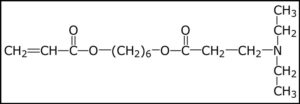
Amino acrylates can vary in reactivity, depending on their amine content and double-bond concentration. The number of abstractable hydrogens and their accessibility (steric hindrance) also affect the reactivity of the amino acrylate. A representative amino acrylate is depicted in Figure 3. It has one acrylate double-bond and six abstractable hydrogens (on the carbon atoms alpha to the nitrogen atom).
The concentrations of both the photoinitiator(s) and the amino acrylates should be optimized for each formulation. In many cases, the use of amino acrylates can reduce the amount of photoinitiator(s) without impacting cure speed.
In this paper, several amino acrylates will be evaluated for their capability to reduce oxygen inhibition and increase surface cure in UV LED curable overprint varnishes. Data on cure speed, as well as other properties will be presented. An amino acrylate also will be evaluated for its capability to reduce oxygen inhibition and increase cure speed in sprayable clear coats.
Food packaging OPVs
For food packaging applications, in addition to performance properties the converted product must meet the requirements for migration into food. The specific migration limits (SMLs) of the appropriate regulation must be met. These SMLs tend to be in the parts per billion (ppb) levels.
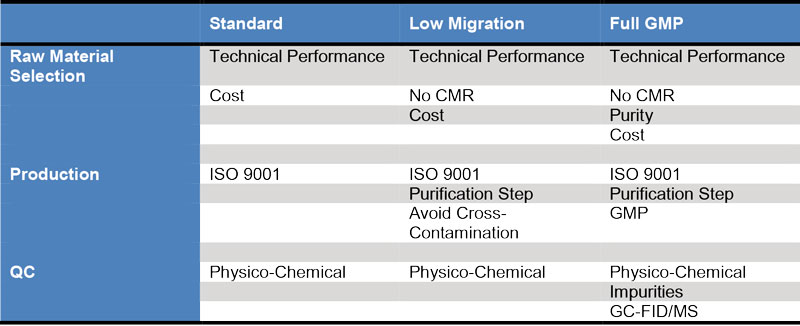
To limit migrating species, special care should be taken in both the selection of raw materials and the manufacturing process. Raw materials should be of certain purity and also not contain carcinogens, mutagens or reprotoxins (CMRs). Cross-contamination during processing should be avoided through proper planning or through good manufacturing practice (GMP). A purification step also may be needed to remove potential migrating species, and quality control may have supplementary purity/cross-contamination specifications. Table 1 shows the differences between standard products, low-migration (LM) products and full GMP products that are used as raw materials in inks and coatings. The formulator also must consider these same constraints, and the convertor needs to meet GMP requirements as well.
Experimental section

The three amino acrylates evaluated in these studies are shown in Table 2. AA1 is a very low viscosity, high amino content material with no acrylate functionality, and typical use levels of 5 to 15%. (Although AA1 does not contain acrylate functionality, it will still be designated as an amino acrylate in this paper.) AA2 is a high-viscosity diacrylate with the lowest amino content. The typical use levels of AA2 are 8 to 15%. AA3 is a medium-viscosity diacrylate with medium amino content and typical use levels of 5 to 20%. AA3 also is designed to be a low-migration material.
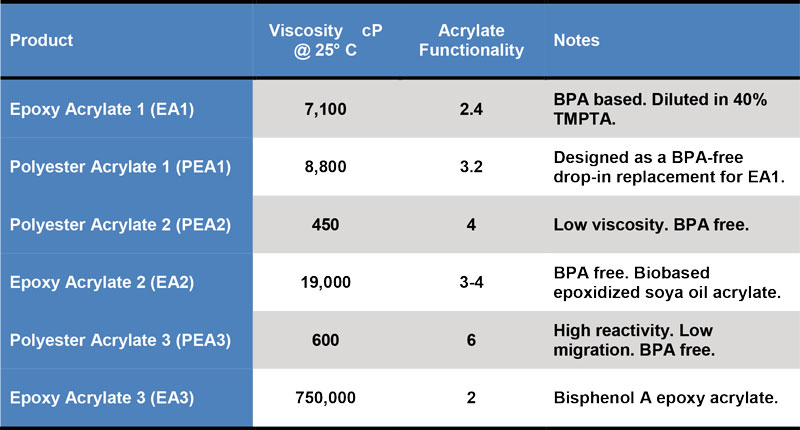
The amino acrylates were used in several OPV and coating formulations that utilized some of the oligomers shown in Table 3. EA1 is bisphenol A epoxy acrylate diluted in 40% trimethylolpropane triacrylate (TMPTA). This type of oligomer is traditionally used in nonfood packaging OPVs. PEA1 was designed as a BPA-free drop-in replacement for EA1, useful for OPVs for food packaging. PEA2 and EA2 are both BPA free and also may be useful in food packaging OPV applications. PEA3 is a low-migration, six functional material used to maintain viscosity in some formulations. EA3 is undiluted bisphenol A epoxy acrylate.
Trimethylolpropane triacrylate (TMPTA), tripropylene glycol diacrylate (TPGDA) and/or ethoxylated trimethylolpropane triacrylate (TMPEOTA) also were used as diluents in the OPV and coating formulations.
Photoinitiators (PI) that absorb in the UVA range are required for UV LED cure. A liquid phosphine oxide type (TPO-L) was used as the main PI in these studies. A thioxanthone type PI sensitizer (DETX) also was evaluated, along with a substituted phosphine oxide (SPO) that requires an amine to be effective.
Photobleaching is particularly pronounced with phosphine oxide type photoinitiators that absorb in the long wavelength (~ 400 nm) region of the spectrum. These photoinitiators are yellow in color before cure. With photobleaching, the absorbance – and yellow color – decrease with exposure time to light of the proper wavelength. This occurs because the absorption characteristics of the photolysis products (from the cleavage reaction) are different from that of the original photoinitiator molecule. Photobleaching enhances optical penetration and lowers the final color of the cured coating or ink. Moreover, this photobleaching continues with time after cure, and the final color is further reduced after 24 to 36 hours. Thioxanthone type photoinitiators do not photobleach, but their photoreaction products are less yellow.
The OPVs were formulated by mixing all of the components together with a speed mixer. The OPVs were then applied to white Leneta charts with a # 2 wire wound bar, resulting in a 5µ thick film. Cure was with an air-cooled 395 nm, 16 watt/cm2 UV LED lamp from Phoseon, at a cure distance of 1 cm. Cure energy was measured with an EIT 365/40W radiometer. Cure speed was determined as the fastest line speed to give a mar-free surface, as tested with a wooden tongue blade. The yellowing index was reported as the b* value, measured with a BYK Spectro-guide Sphere. Yellowing was measured immediately after cure and 24 or 36 hours after cure. Viscosities were measured with an Anton Paar MCR 101 Rheometer.
The clear coatings were formulated by mixing all the components together with a speed mixer. The coatings were then applied to white Leneta charts with a spray gun resulting in either a 12µ or 20µ film. Cure was with either a water-cooled 395 nm, 24 watt/cm2 UV LED lamp or an air-cooled 365 nm, 8 watt/cm2 UV LED lamp, both from Phoseon, at a cure distance of 1 cm. The 24W/cm2 UV LED lamp also was adjusted to deliver 8, 12 and 16 W/cm2. Cure speed was determined as the fastest line speed to give a mar-free surface as tested with a fingernail. Yellowing was measured with a Supercolor from Braive Instruments and is reported as the delta b value (b value of the cured coating – b value of the substrate).
UV LED curable OPV formulations
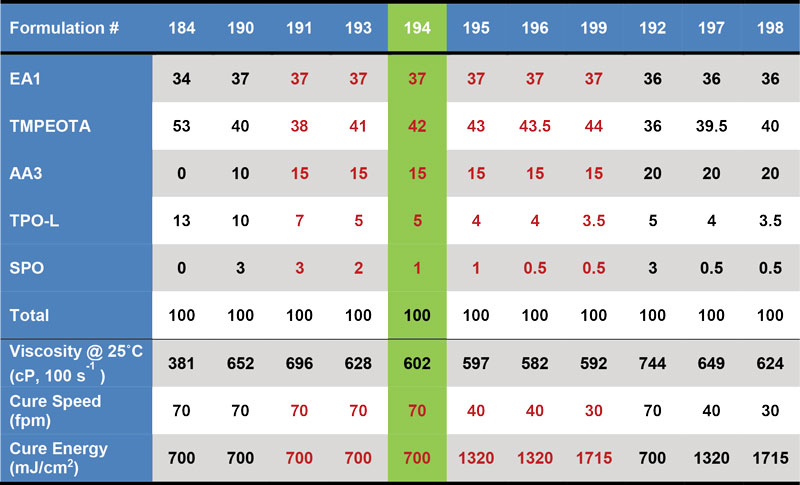
Table 4 shows the OPV formulations that were tested to optimize the photoinitiator levels and the acrylated amine levels. [There are viscosity effects with UV LED cure, so the formulations (except 184) were designed to maintain similar viscosities.] The main photoinitiator, TPO-L, could be reduced from 13 to 5% through the use of 15% AA3 and 1% co-initiator, SPO. The cure speed was maintained at 70 fpm in the optimized formulation #194. (Without the use of amino acrylates, the cure speed of formulation #194 was ‹ 15 fpm.) This optimized PI package will be used in further studies.
The co-initiator, SPO, was chosen based on earlier work that evaluated a photoinitiator package containing 10% TPO-L and 3% of either DETX or SPO. The cure speeds of both PI packages were the same with the various oligomers. However, the yellowing index was dramatically different for formulations containing either DETX or SPO. The DETX-based formulations resulted in yellowing indices in the range of 9 to 17. The SPO formulation was much less yellow, with yellowing indices of 5 to 8. The DETX also is on the Nestle Exclusion List and should not be used in coatings or inks intended for food packaging.
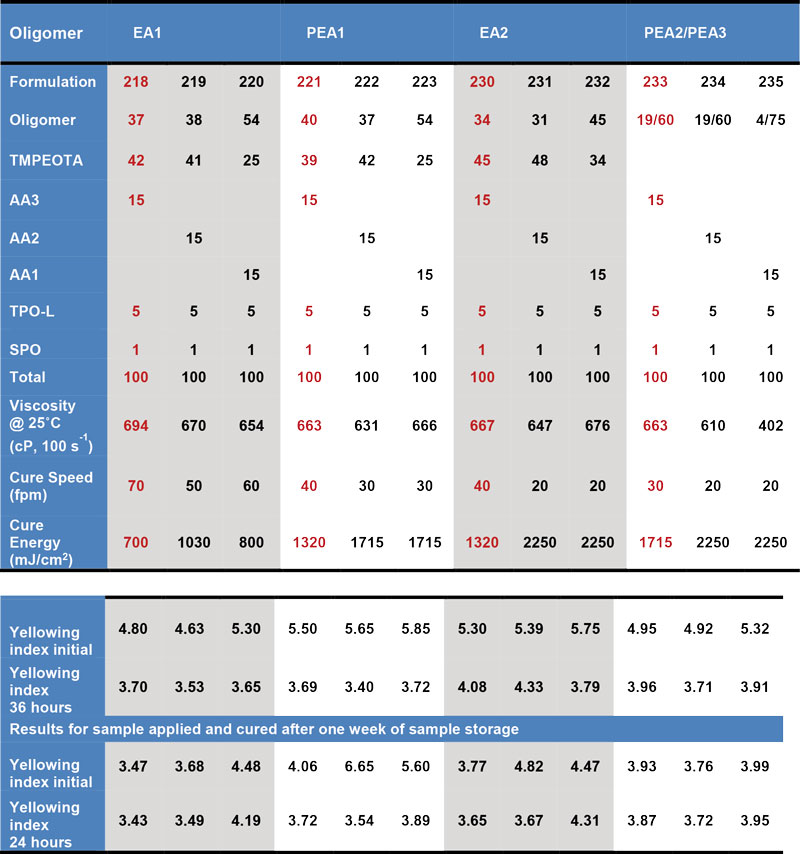
The yellowing indices of the formulations shown in Table 5 were all around 4 (initial) and were reduced about 0.1 units after 24 hours. (These yellowing indices were for OPV formulations that were stored for one week and then cured.)
Using the optimized levels of photoinitiators and acrylated amine, cure speeds were assessed for multiple oligomer types using the three different acrylated amines. Table 5 shows these data. Cure speeds varied with oligomer type. The bisphenol A-based epoxy acrylate (EA1) had the fastest cure speeds, regardless of which acrylated amine was used. Bisphenol A-based epoxy acrylates are known for their fast cure speeds with mercury lamps, and this fast reactivity remains with UV LED lamps. PEA1, the drop-in replacement for EA1, was the next fastest, followed by the epoxidized soya oil acrylate (EA2) and the PEA 2/PEA3 blend. For all of the oligomer types, the use of AA3 provided the fastest cure speed. Not shown are data for the Table 5 formulations that did not contain acrylated amine. These formulations did not cure at even the slowest conveyor speed of 15 fpm.
If a food packaging OPV is required, only the formulations that use AA3 and do not use EA1 are BPA-free and based on materials that could be appropriate for this application.
Table 5 also reports several yellowing indices. The yellowing index was measured on formulations that were freshly prepared and cured the same day as well as on formulations that were stored for one week and then cured. Additionally, the yellowing index was measured immediately after cure and 24 or 36 hours after cure. In all cases, photobleaching was observed as a reduction in the yellowing index 24 or 36 hours after cure. The final yellowing index ranged from 3.4 to 4.3 for all formulations.
Surprisingly, the formulations that were stored for one week and then cured gave initial yellowing indices that were generally 1 unit lower than the formulations that were prepared and cured the same day. There was not much difference in the yellowing indices measured after 24 or 36 hours, however.
To summarize, a low-yellowing PI package has been identified for UV LED-curable OPV formulations. The main photoinitiator, TPO-L, could be reduced from 13 to 5% without impacting cure speed through the use of 15% acrylated amine (AA3) and 1% co-initiator (SPO). The cure speeds of three acrylated amines were compared. AA3 was faster than AA1 or AA2. The AA3 is also the only acrylated amine designed for low-migration applications, such as food packaging.
Sprayable UV LED curable clear coats
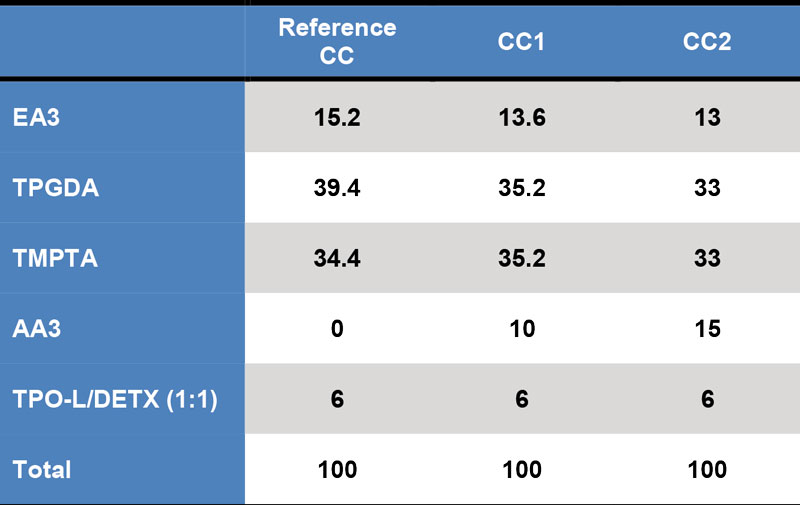
Table 6 shows the compositions of the sprayable clear coats. The bisphenol epoxy acrylate (EA3) was diluted with TPGDA and TMPTA and then photoinitiated with a 1:1 blend of TPO-L and DETX. The Reference Clear Coat (CC) did not contain any amino acrylate. Clear Coat 1 (CC1) contained 10% AA3, and Clear Coat 2 (CC2) contained 15% AA3. The viscosities for all three clear coats were maintained at 200 cP at 25°C to avoid viscosity effects on cure speed.
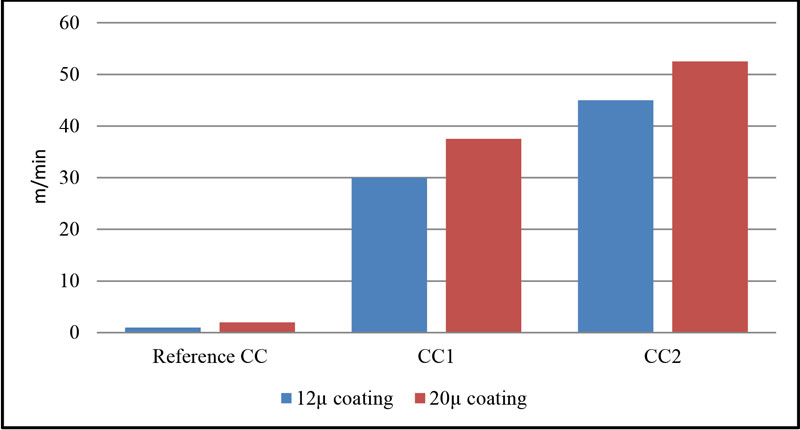
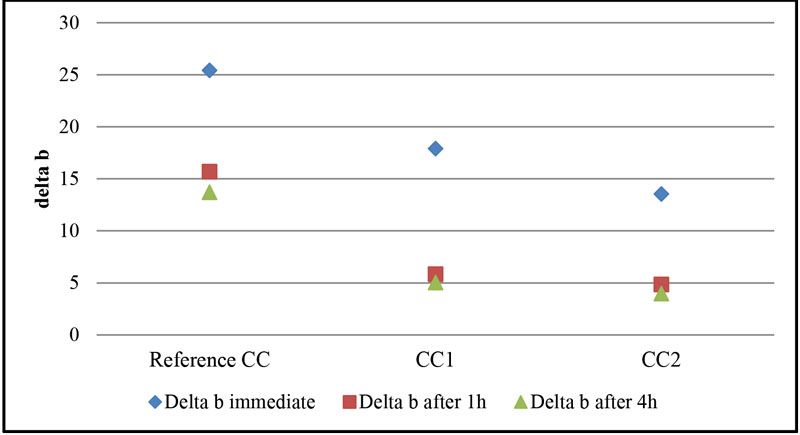
Both 12µ and 20µ clear coats from Table 6 were cured with a 365 nm, 8 watt/cm2 UV LED lamp. Figure 4 shows the increase in cure speed with increase in concentration of amino acrylate and with increase in coating thickness. The cure speed of the 12µ coating was boosted 30-fold for CC1 (10% AA3) and 45-fold for CC2 (15% AA3).
Figure 5 shows the yellowing data for the 12µ clear coats from Table 6 at three points in time: immediately after cure, 1 hour after cure and 4 hours after cure. As the amount of the amino acrylate (AA3) was increased, yellowing was decreased. Increasing the amino acrylate concentration increased the conversion of the DETX (as shown in Figure 2), lowering the color of the coating. As discussed earlier, the TPO-L also photobleaches, so even lower color can be expected after 24 to 36 hours.
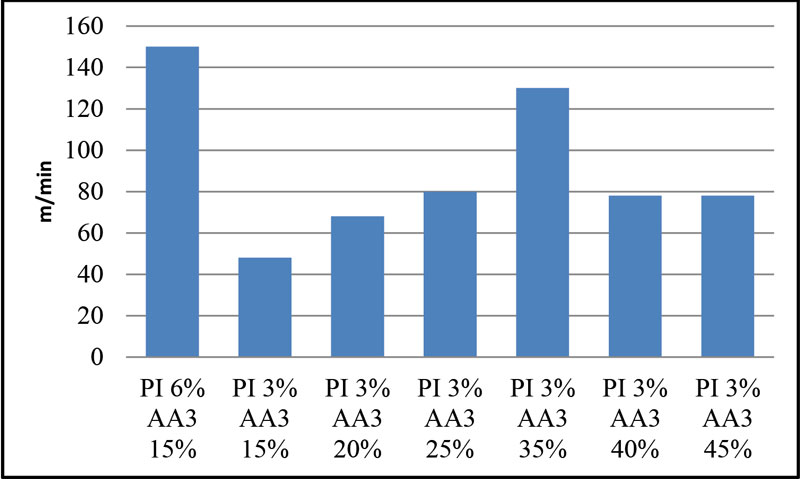
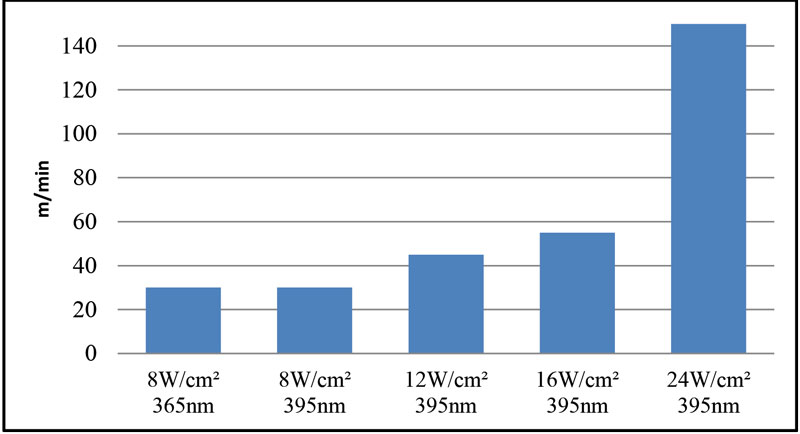
The ability of AA3 to maintain cure speed while reducing PI content was investigated. These results are shown in Figure 6 for a 12µ CC2-type coating cured with a 395 nm, 24W/cm2 UV LED lamp. Decreasing the PI content by half (6 to 3%), while maintaining the AA3 content at 15%, reduced cure speed from 150 m/min to 48 m/min. The AA3 content was then increased in 5% increments, from 15 to 45%, to evaluate the impact on cure speed. Increases in cure speed were seen until 35% AA3 content was reached. At this level of AA3, the cure speed was 130 m/min, very close to the original cure speed. Further increasing the AA3 level resulted in decreases in cure speed, indicating that formulation optimization for AA3 content is important.
The impact of the type of UV LED equipment (different irradiance and/or wavelength emission) on the cure speed for CC2 (12µ coating) is shown in Figure 7. At 8W/cm2 irradiance, there was no difference in maximum cure speed between a 365 nm and a 395 nm UV LED lamp. However, increasing the irradiance of a 395 nm wavelength UV LED from 8, 12 or 16 W/cm2 to 24 W/cm2 showed significant reactivity differences. Cure speed increased fivefold when moving from 8 W/cm2 to 24 W/cm2 and tripled when moving from 12 or 16 W/cm2 to 24 W/cm2.
In summary, the cure speed of sprayable clear coats can be increased 45 times through the use of 15% amino acrylate (AA3). A decrease in yellowing also was seen when AA3 was used. Photoinitiator levels can be decreased, and cure speeds maintained, through the use of amino acrylate AA3.
No differences in cure speed were seen between 365 nm and 395 nm 8W/cm2 UV LED lamps. However, at 395 nm, cure speed was significantly increased when increasing irradiance from 8, 12 or 16 W/cm2 to 24 W/cm2.
…formulations that were stored for one week and then cured gave initial yellowing indices that were generally 1 unit lower than the formulations that were prepared and cured the same day.
Overall conclusions
Acrylated amines can be used to either increase UV LED cure speed at existing PI concentrations or maintain UV LED cure speed at reduced PI concentrations. AA3 was the most effective acrylated amine in the OPVs that were studied. In sprayable clear coatings, increases in cure speed, with decreases in yellowing, were obtained through the use of AA3.
For UV LED curable OPV formulations, a low-yellowing PI package was identified that should be acceptable for food packaging applications. The low-migration AA3 was part of this formulation.
For UV LED lamps with the same wavelength emission, increases in irradiance gave faster cure speed. Changes in wavelength emission at the same irradiance showed no differences in cure speed.
References
- Y. Muramoto, M. Kimura and S. Nouda, Development and future of ultraviolet light-emitting diodes: UV LED will replace the UV lamp. Semiconductor Science and Technology, 29 (2014).
- J. Heathcote, Characterizing UV LED Curing Systems. 2018 UV+EB Technology Expo & Conference Proceedings.
- R. Schwalm, UV Coatings: Basics, Recent Developments and New Applications, pp 179-184. Elsevier 2007.
- J. Arceneaux, Mitigation of Oxygen Inhibition in UV LED, UVA and Low Intensity UV Cure. UV+EB Technology, Vol. 1 No. 3, pp 48-56.
- J. Fouassier and J. Rabek, Radiation Curing in Polymer Science and Technology, Volume III, pp 33-64. Elsevier Science Publishers LTD 1993.
ACKNOWLEDGEMENTS
The experimental work was carried out and reported on by my co-authors and colleagues: Celia Buono, Steven Cappelle, Kevin Poelmans and Carmen Van Vaerenbergh.


